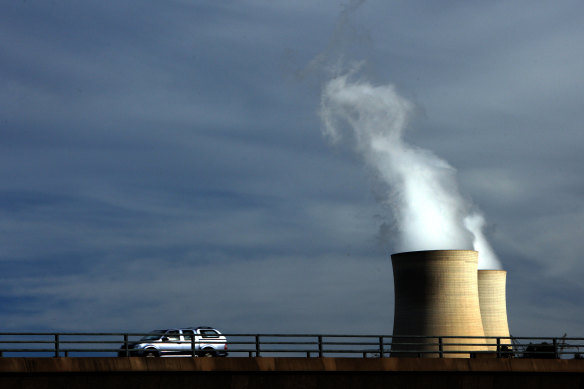By Nick Toscano
Australia’s largest power station operator is trialling a complete shutdown of some units during the day while other companies are cutting back output to their lowest levels ever as they fight to dodge spiralling losses when solar panels swamp the grid.
The rollout of large-scale renewables and millions of rooftop solar panels has been radically reshaping eastern Australia’s energy market, unleashing vast amounts of cheap electricity and pummelling the prices generators receive on sunny and windy days to $0 or below for hours at a time.

Power giant AGL is testing ways to turn off its coal units so it can dodge the daytime onslaught of rooftop solar flooding the grid with cheap electricity.Credit: Rob Homer
Plants that burn coal are the most exposed to the shock of increasingly volatile price swings because their turbines lack the ability to easily ramp generation up and down, even if they are struggling to compete.
While coal plants typically always run at a minimum level to avoid the costly and complicated process of switching on and off, energy giant AGL last month carried out an Australia-first trial of taking one of the units at its Bayswater generator in NSW offline for five hours and returning it to service in the afternoon.
AGL chief operating officer Markus Brokhof said the company had gained insights for the trial following a visit to the Ratcliffe-on-Soar power station in the United Kingdom, which closed last week after 57 years. He said the trial shutdown at Bayswater from 10am to 3pm on September 7 had demonstrated to the company that it could be done.
“This has shown us, from an operational point of view, that it is possible to switch off a unit,” Brokhof said.
“It seems to work, and our people are getting familiar with it.”
The process known as “two-shifting” – taking a unit offline and bringing it back in a 12-hour period – could help plants cut their emissions by reducing the need to burn coal unnecessarily, and improve their profitability by avoiding heavy financial losses during the day.
AGL, which also owns the Loy Yang A coal-fired power station in Victoria’s Latrobe Valley, regards the trial as a potentially significant breakthrough.
“We don’t want to produce energy when prices are negative,” Brokhof said.
“From a financial and economical point of view, there is quite an incentive to explore this further.”
Coal has been the backbone of Australia’s power grid for more than half a century, but the fossil fuel is also a dominant source of greenhouse gas emissions that pollute the air and are dangerously heating the planet.
The United Nations wants rich countries to phase out coal by as soon as 2030 to help avert the worst impacts of global warming. The Albanese government’s legislated target to slash emissions by 43 per cent by 2030 relies heavily on replacing coal plants with more wind, solar and hydropower.

AGL chief operating officer Markus Brokhof.Credit: Eamon Gallagher
However, the threat of unprofitable coal-fired power plants being forced to close ahead of schedule has become a worry for grid planners and state governments amid warnings that not enough renewables, storage and power lines are being built to avoid blackouts or price spikes at times of low wind and sunlight once more coal retires.
Origin Energy, which had planned to close its giant Eraring coal power station by as early as August next year, reached an agreement with the NSW government in May to keep its plant running until at least 2027. The Victorian government has also cut secret deals to support two coal plants – Yallourn and Loy Yang A – to ensure they do not close prematurely and leave the state vulnerable.
Brokhof said AGL needed to gain more data from the Bayswater two-shifting trial to understand any risks for “wear and tear” before it would consider implementing it. Repeatedly ramping up and down could possibly shorten plant equipment’s lifespan and require more maintenance.
But if successful, two-shifting could boost the prospects of AGL’s remaining coal plants staying viable until their intended closure dates next decade, Brokhof said.
“With this kind of operation, we would be able to stay in the market and still make money,” he said.
Other owners of coal-fired power stations across the eastern coast grid have also been working on ways to make their plants more flexible and able to withstand rock-bottom or negative daytime wholesale prices, with some generators now able to dial back output to below 30 per cent of their maximum capacity.
Last month, Origin Energy announced it had gained approval from the market operator to reduce the minimum load of each of Eraring’s four generating units by a further 14 per cent to 180 megawatts – just 25 per cent of their nameplate capacity.
The Business Briefing newsletter delivers major stories, exclusive coverage and expert opinion. Sign up to get it every weekday morning.